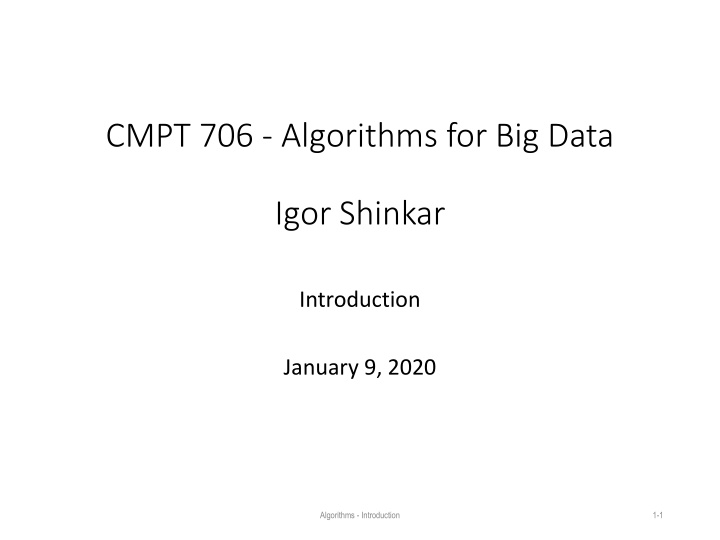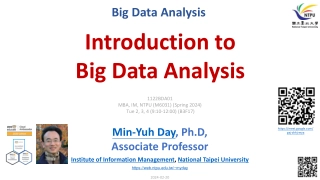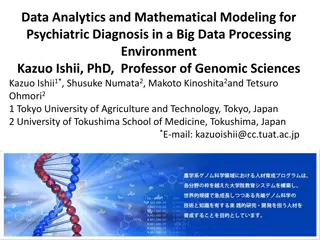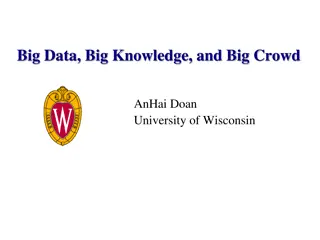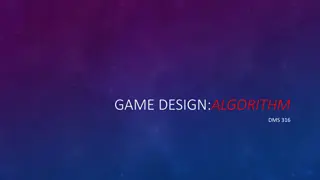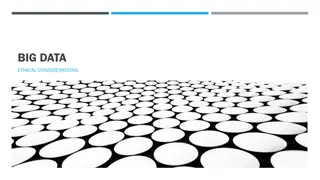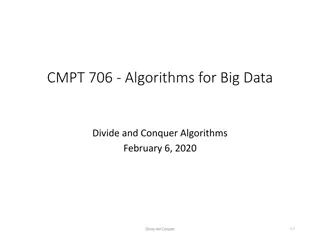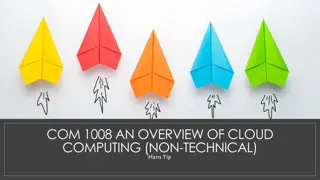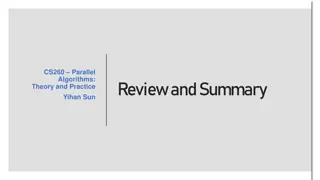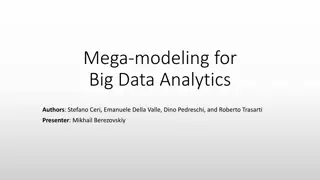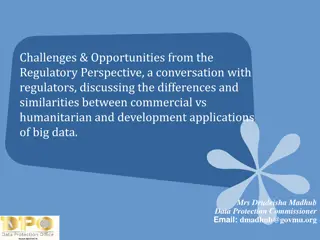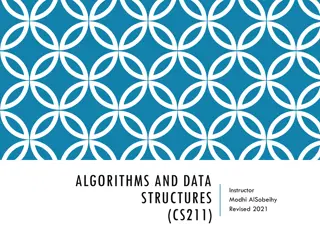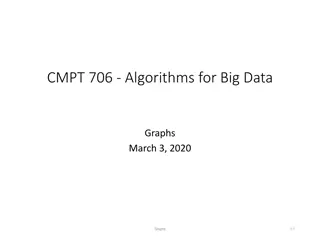Algorithms for Big Data - Introduction and Course Overview
In this course, led by Instructor Igor Shinkar, you will delve into algorithmic techniques and methods used in big data analysis. The syllabus covers topics like Divide-and-Conquer, Greedy Algorithms, and more. With a tentative schedule mapped out and resources like the textbook by Dasgupta, Papadimitriou, and Vazirani at your disposal, you will gain a solid foundation in algorithm analysis for big data applications.
Download Presentation

Please find below an Image/Link to download the presentation.
The content on the website is provided AS IS for your information and personal use only. It may not be sold, licensed, or shared on other websites without obtaining consent from the author.If you encounter any issues during the download, it is possible that the publisher has removed the file from their server.
You are allowed to download the files provided on this website for personal or commercial use, subject to the condition that they are used lawfully. All files are the property of their respective owners.
The content on the website is provided AS IS for your information and personal use only. It may not be sold, licensed, or shared on other websites without obtaining consent from the author.
E N D
Presentation Transcript
CMPT 706 - Algorithms for Big Data Igor Shinkar Introduction January 9, 2020 Algorithms - Introduction 1-1
Course Info Instructor: Igor Shinkar Email: ishinkar@sfu.ca Room: TASC 9017 Office hours: Tuesdays 14:30 15:30 TAs: Amirhossein Mozafari Khameneh amozafar@sfu.ca Mehak Parashar mehak_parashar@sfu.ca Office hours / Discussion sessions: TBA Course Webpage https://www.cs.sfu.ca/~ishinkar/ teaching CMPT 706 Piazza - Discussion forum for questions / announcements you will receive an invitation. Algorithms - Introduction 1-2
Course Info Course Objectives: introduce the basic algorithmic techniques and methods of algorithm analysis, and to demonstrate how these techniques are used in big data algorithms Algorithms - Introduction 1-3
Course Syllabus (Tentative) Algorithmic techniques: Unit 1: Introduction and Algorithms with Numbers Unit 2: Divide-and-Conquer Unit 3: Graphs and Graph Algorithms Unit 4: Greedy Algorithms Unit 5: Dynamic Programming Unit 6: Approximation and Randomized algorithms Big Data Topics: Algorithm Design for Map-Reduce: Analysis and trade-offs Algorithms for Large-Scale Graphs: Vertex-centric/Edge-centric approaches Consistency in Large Distributed Systems: Paxos consensus, CAP theorem Algorithms for Large Datasets: Time-accuracy trade-offs Streaming Algorithms Algorithms - Introduction 1-4
Textbook Dasgupta, Papadimitriou, Vazirani, Algorithms, McGraw-Hill Higher Education, 2008. Errata for the textbook http://cseweb.ucsd.edu/~dasgupta/book/errata.pdf Algorithms - Introduction 1-5
Additional references Kleinberg, Tardos, Algorithm Design Cormen, Leiserson, Rivest, Stein, Introduction to Algorithms D. E. Knuth, The Art of Computer Programming. Vol. 1,2,3,4, V. V. Vazirani, Approximation Algorithms M. Mitzenmacher and E. Upfal, Probability and Computing: Randomized Algorithms and Probabilistic Analysis Algorithms - Introduction 1-6
Grading scheme 5 assignments 4 x 5% (best 4 out of 5) 5 quizzes 4 x 10% (best 4 out of 5) Final exam 40% Participation/piazza 5% Algorithms - Introduction 1-7
Prerequisites Some general CS knowledge. Binary representation of numbers Basic math erudition Can plot function x , x2 , x3 , ln(x) , ln2(x) , 2x , etc Sum of arithmetic/geometric progression Some experience in programming Able to write a program in any programming language If/else, for/while, functions Recursion Algorithms - Introduction 1-8
Algorithms vs Heuristics Algorithms Heuristics Problem is well defined: we know what the right output is for each input Correctness is provable Problem is not necessarily well defined: we know what the output is for regular inputs Method is `usually correct for `interesting inputs Some performance guarantees can be proved Example: given two numbers compute their sum Performance is measured on test or benchmark inputs Example: given a picture distinguish between a cat and a dog Algorithms - Introduction 1-9
Algorithmic Paradigms Greedy algorithms Divide-and-Conquer Dynamic Programming Network Flow Linear/Integer/Convex Programming Approximation Algorithms Randomized Algorithms Streaming Algorithms Quantum Algorithms Algorithms - Introduction 1-10
Computing the sum of two numbers Input: two positive integers x, y Output: x+y Example: x = 1265, y=762 1 1 Algorithm: 1 2 6 5 + 7 6 2 7 2 0 2 Algorithms - Introduction 1-11
Computing the product of two numbers Input: two positive integers x, y Output: x*y Example: x = 65, y=26 6 5 x 2 6 Algorithm: 3 9 0 + 1 3 0 1 6 9 0 Algorithms - Introduction 1-12
Factoring an integer into a product of two numbers Input: a positive integers N Output: two numbers x,y >1 such that x*y = N (or say that N is prime) Example: N = 561 A possible solution 11, 51 A na ve algorithm: For x=2 N-1 if N is divisible by x Compute y = N/x Output x,y Algorithms - Introduction 1-13
Factoring an integer into a product of two numbers Input: a positive integers N Output: two numbers x,y >1 such that x*y = N (or say that N is prime) Example: N = 561 A possible solution 11, 51 Suffices to check up to N1/2 because either x or y are at most than N1/2 A slightly better algorithm: For x=2 N1/2 if N is divisible by x Compute y = N/x Output x,y Algorithms - Introduction 1-14
The closest pair problem Input: A collection of ? points in the plane Goal: Find a pair of points that are closest to each other min Algorithms - Introduction 1-15
The closest pair problem Input: A collection of ? points ?1,?2,?3, ,?? in the plane Output: A pair of points ??,?? such that d???(??,??) is minimal. Is the algorithm correct? Is the algorithm correct? Algorithm: 1. Set ? = ?1,? = ?1 2. Set ??? = ???? ?,? 3. For ? = 1, ? For j = 1, ? if ???? ?_?,?_? < ??? ? = ??,? = ?? ??? = ???? ??,?? 4. Return (?,?) min Algorithms - Introduction 1-16
The closest pair problem Input: A collection of ? points ?1,?2,?3, ,?? in the plane Output: A pair of points ??,?? such that d???(??,??) is minimal. Can we make it a bit more efficient? Algorithm: 1. Set ? = ?1,? = ?1 2. Set ??? = ???? ?,? 3. For ? = 1 ? For j = 1 ? if ? ? ??? ???? ?_?,?_? < ??? ? = ??,? = ?? ??? = ???? ??,?? 4. Return (?,?) min Algorithms - Introduction 1-17
The closest pair problem Input: A collection of ? points ?1,?2,?3, ,?? in the plane Output: A pair of points ??,?? such that ????(??,??) is minimal. Is the algorithm correct now? Algorithm: 1. Set ? = ?1,? = ?1 2. Set ??? = ???? ?,? 3. For ? = 1 ? For ? = ? + 1 ? if ???? ?_?,?_? < ??? ? = ??,? = ?? ??? = ???? ??,?? 4. Return (?,?) min What is the running time of the algorithm? Algorithms - Introduction 1-18
Running time of algorithm How do we analyze the running time? We have 3 set operations in the beginning + one return in the end. The total number of iterations of the algorithm is ? 1 + ? 2 + ? 3 + + 2 + 1 This is the sum of an arithmetic series and it is equal to ?(? 1) . 2 How many operations do we perform in each iteration? What is the total number of operations performed by the algorithm? Algorithms - Introduction 1-19
Running time of algorithm What is the running time of the algorithm that computes the sum of two numbers? What is the running time of the algorithm that computes the product of two numbers? Q: How should we express the runtime? Na ve A: it is some function of the input We will usually measure the runtime as a function of the length of the input Algorithms - Introduction 1-20
Running time of algorithm The length of the input is defined as the number of bits required to represent the input. What is the length of the input in the summation/multiplication problems? Q: How many decimal digits are needed to represent the number ?? A: Approximately log10(?)(I m probably off by one) Q: How many bits are needed to represent the number ?? A: : Approximately ???2(?)(I m probably off by one) For example: the number 25 in binary is represented as 11001 = 1 24+ 1 23+ 0 22+ 0 21+ 1 20= 25 Algorithms - Introduction 1-21
Running time of algorithm Q1: What is the running time of the algorithm that computes the sum of two numbers? Q2: What is the running time of the algorithm that computes the product of two numbers? Q3: What is the running time of the algorithm that factors a number into a product of two numbers? Algorithms - Introduction 1-22
Running time of algorithm Q: What is the running time of the algorithm that computes the sum of two numbers? A: On input x,y the runtime is approximately (log2(x)+log2(y)) * const Comment: if x has more digits than y, then then runtime is ~log2(x) + const x log2(y), because we only need to copy some digits of x, and not do any computation. Algorithms - Introduction 1-23
Reading for next time Dasgupta, Papadimitriou, Vazirani, Algorithms, McGraw-Hill Higher Education, 2008. Chapter: 0 1.1, 1.2: 1.2.1, 1.2.2 Algorithms - Introduction 1-24
